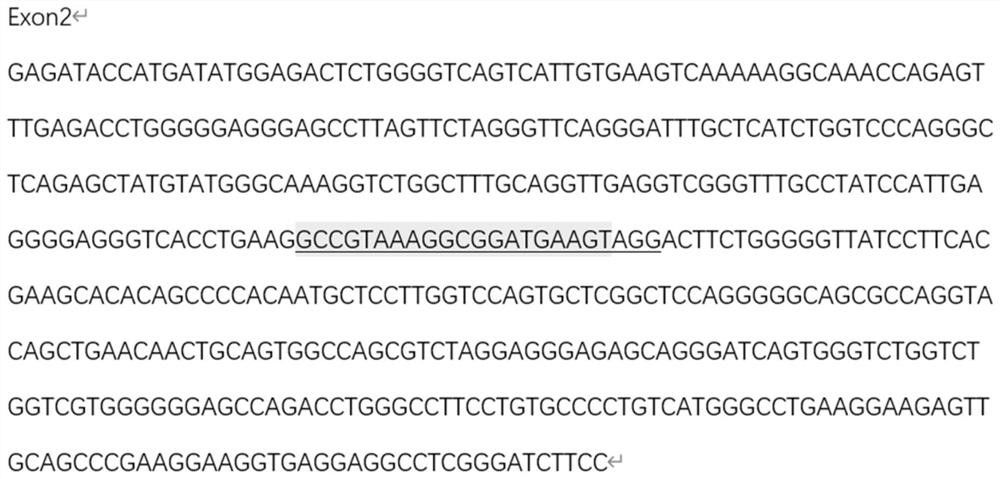GRNA of WAS gene and application of gRNA
A gene, gene editing technology, applied in DNA/RNA fragments, genetic engineering, gene therapy, etc., can solve problems such as unobserved eczema and joint abnormalities
- Summary
- Abstract
- Description
- Claims
- Application Information
AI Technical Summary
Problems solved by technology
Method used
Image
Examples
Embodiment 1
[0051] Example 1 Design and Construction of CRISPR / Cas9 Gene Editing System
[0052] (1) Design gRNA
[0053] This embodiment first analyzes the homology between the rabbit WAS gene and the human WAS gene, as well as the site with a higher mutation frequency of the WAS gene that has been reported to cause Wiskott-Aldrich syndrome, and determines that exon 2 and exon 2 of the rabbit WAS gene Selection of target sites around exon 7;
[0054] Download the rabbit WAS gene sequence from NCBI, according to the selection requirements of the spCas9 gene target site and the transcription requirements of the pT7-gRNA in vitro transcription vector, select the target site around exon 2 and exon 7, and design two gRNAs ( gRNA1 and gRNA2), such as Figure 1A and Figure 1B Shown are the partial sequences of exon 2 and exon 7 of the rabbit WAS gene, and the highlighted sequences are the target sequences of gRNA1 and gRNA2, respectively;
[0055] gRNA1 (SEQ ID NO: 1): ACTTCATCCGCCTTTACGGC;...
Embodiment 2
[0061] Example 2 Preliminary estimation of WAS gene editing efficiency of CRISPR / Cas9 gene editing system
[0062] Collect and select rabbit fertilized eggs before and after the pronuclear stage for use; prepare micromanipulation needles, including fixation needles and injection needles; mix gRNA and Cas9 according to the ratio of gRNA1:gRNA2:Cas9 mRNA=15ng / μL:15ng / μL:200ng / μL mRNA, inject gRNA and Cas9 mRNA mixture into the rabbit fertilized eggs before and after the pronuclear stage; place the injected fertilized eggs in an incubator for culture, collect embryos at about 4 days, and use NP40 lysate (0.45% NP40 and 60 μg / mL proteinase K ) cleavage in a PCR machine, and use the cleavage product as a template to carry out conventional PCR or nested PCR, and the PCR primers are shown in SEQ ID NO: 3-9;
[0063] WAS-2F (SEQ ID NO: 3): CCTCCTCACCTTCCTTCGG;
[0064]WAS-2R (SEQ ID NO:4):TTCTAGGGTTCAGGGATTTGCT;
[0065] WAS-7F (SEQ ID NO: 5): ATGGTTATTAATGGTTTATGGGATC;
[0066] WA...
Embodiment 3
[0073] Example 3 Construction of Wiskott-Aldrich Syndrome Rabbit Model
[0074] (1) Microinjection of fertilized eggs
[0075] Collect and select rabbit fertilized eggs before and after the pronuclear stage for use; prepare micromanipulation needles, including fixation needles and injection needles; mix gRNA and Cas9 according to the ratio of gRNA1:gRNA2:Cas9 mRNA=15ng / μL:15ng / μL:200ng / μL For mRNA, inject the mixture of gRNA and Cas9 mRNA into the cytoplasm of rabbit fertilized eggs before and after the pronuclear stage; the injected fertilized eggs are cultured in an incubator, and embryos in good condition are selected and transplanted into female rabbits.
[0076] (2) Delivery and Nursing
[0077] About 15 days after the embryo transfer, judge whether the recipient female rabbit is pregnant; for the pregnant recipient female rabbit, appropriately increase the feed and green feed such as carrots and vegetables to ensure the nutritional needs of the female rabbit; about 28 d...
PUM
 Login to View More
Login to View More Abstract
Description
Claims
Application Information
 Login to View More
Login to View More - R&D
- Intellectual Property
- Life Sciences
- Materials
- Tech Scout
- Unparalleled Data Quality
- Higher Quality Content
- 60% Fewer Hallucinations
Browse by: Latest US Patents, China's latest patents, Technical Efficacy Thesaurus, Application Domain, Technology Topic, Popular Technical Reports.
© 2025 PatSnap. All rights reserved.Legal|Privacy policy|Modern Slavery Act Transparency Statement|Sitemap|About US| Contact US: help@patsnap.com



